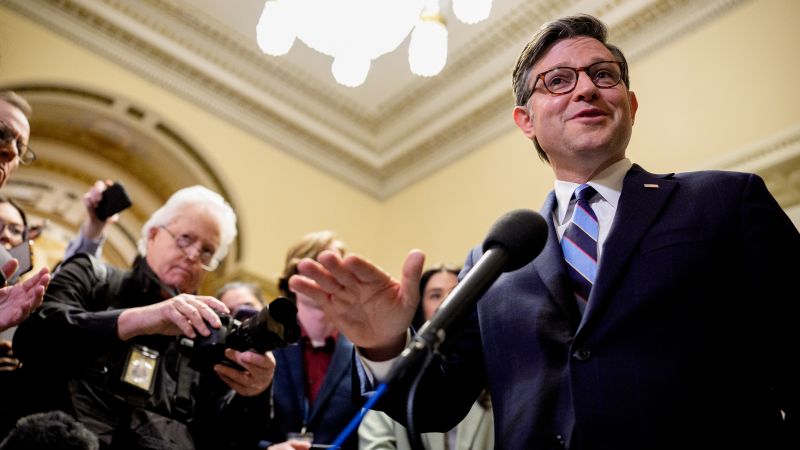CNN
—
Speaker Mike Johnson has relied on one strategy so far in his chaotic GOP House: Survive and advance.
The Louisiana Republican notched another unlikely victory last week, convincing his most recalcitrant conservatives to back a budget blueprint they detested — all without losing the votes of moderates.
With the first 100 days of the GOP Congress now behind him, Johnson is heading into a much bigger battle, this time over far thornier details of President Donald Trump’s legislative agenda. But after Johnson’s public vow that the final bill would contain at least $1.5 trillion in spending cuts — all without adding to the deficit and making Trump’s tax cuts permanent — some Republicans told CNN they’re not sure how Johnson gets through this next and most consequential round.
“I’m not optimistic. When you get pen to paper and you see exactly what we’re doing, and then the hope that the Senate is gonna match us, you’ve got to be smoking dope,” one skeptical House GOP lawmaker told CNN, speaking on the condition of anonymity to speak candidly of intraparty dynamics.
“This is a pipe dream if you think that Thune in the Senate is gonna be about to get to a trillion and a half cuts for them,” this lawmaker said, referring to Senate Majority Leader John Thune.
Added Rep. Nicole Malliotakis of New York: “I don’t really believe that the number will be $1.5 trillion. I think that it probably will come in a little lower.”
But House GOP hardliners say they will not accept anything less than $1.5 trillion in cuts on the final bill.
Georgia Rep. Rich McCormick, one of the conservative holdouts who ultimately backed the budget blueprint, said a bill is “not going to get done” if it has fewer cuts.
“I promise you, you’ll not just have me, you’ll have 30 people that won’t vote for it,” McCormick said.
The House’s adoption of the Senate budget blueprint was supposed to be the easy part, but it took weeks of wrangling behind the scenes for Johnson to secure its approval with no margin for error, on a 216-214 vote.
Now that they’ve approved the blueprint, Republicans can advance legislation through a process known on Capitol Hill as reconciliation, which cannot be filibustered in the Senate — meaning the GOP can pass the plan along straight party lines.
But Republicans are nowhere close on the details of the bill, which deal with complex issues, including a major overhaul of the US tax code, beefed-up immigration enforcement measures, new projects for energy drilling, a two-year hike of the national debt limit, and spending cuts from unspecified federal programs.
This all comes as GOP leaders have set aggressive deadlines for themselves, with some gunning to pass the full package by Memorial Day. The pressure is high with the White House eager to notch legislative wins amid a trade war and a debt default looming later this year — and so are the political stakes, as Democrats prepare to pounce on every legislative twist and turn ahead of the crucial 2026 midterms.
Now as Congress departs for a two-week recess, Republicans acknowledge the real work is about to begin.
Behind the scenes, frustrations are already building over the Republicans’ big spending cuts goal. As hardliners demanded their own promises, Johnson was also forced to tamp down a mini rebellion among Northeastern Republicans, who demanded the speaker publicly pledge to protect Medicaid.
New Jersey Rep. Jeff Van Drew, who was among those who extracted the Medicaid promise from Johnson, warned that Republicans like himself would be extremely vocal as the final bill takes shape.
“Let me be blunt. If there are folks on the other side of this who want to hurt people, who want to cut to the bone, then we are not voting on this,” Van Drew said. “We’re nice guys. By and large, we always roll over. But it’s not going to continue to happen.”
The White House and GOP leadership have promised those cuts would not affect benefits from major entitlement programs like Social Security, Medicare and Medicaid. But there’s ample skepticism in the ranks.
“I will not support cuts in Medicaid that harm people with disabilities, low-income families, our seniors, our rural hospitals and other health care providers. I am open to a work requirement that is carefully tailored to able bodied adults without young children,” said Sen. Susan Collins, a Republican from Maine facing reelection next year.
Collins questioned how a requirement that one House committee with oversight of Medicaid could find more than half of the overall desired savings without touching that program.
“I don’t know how the instruction to the Energy and Commerce Committee of $880 billion can be met without cutting benefits from Medicaid, but I may be wrong,” she said. “Maybe they have some magic formula.”
Added another key swing vote, Sen. Lisa Murkowski of Alaska: “I’m concerned about how we’re going to figure out how we do this between the two bodies. I’m gonna be worried about Medicaid until we get on the other side of this so I don’t have to be worried about Medicaid.”
Thune signaled he understands he’ll have to bridge the divide.
“We got folks on both sides of that issue,” the South Dakota Republican said when asked about concerns that the $1.5 trillion in spending cuts is too high. “We’ll have to sort it out.”
In a single week, GOP leaders flipped dozens of holdouts — some 64, by one leadership aide’s count — to take the procedural leap to unlock the reconciliation process. And Republicans insist they can do it again on the final bill, saying Johnson has proved his skeptics wrong time and again — whether it’s been about a March spending bill to keep the government open, winning the speaker’s gavel in January or this latest battle that led to a cliffhanger vote on the House floor.
“Nothing ever comes easy in the US House,” said Republican Rep. Dusty Johnson, a leadership ally, who acknowledged the GOP conference is full of people with “strong opinions on most everything.”
“There’ve been a lot of people who have counted us out every single time,” said Johnson, a South Dakota congressman. “We have won despite that, and we’re gonna win this time too.”
But some fissures have begun to show among the speaker’s leadership team. On Wednesday night, for instance, House Majority Whip Tom Emmer and his whip team believed they had narrowed the “no” votes down to a point where they could vote instead of punting until the next morning, according to three people familiar with the discussions.
Then, Mike Johnson — under pressure from conservatives demanding a meeting — decided to call a joint meeting of the roughly 20 holdouts during the vote, where GOP leaders seemed to lose ground. That left Emmer furious, those people familiar said.
But separately, people close to Johnson and House Majority Leader Steve Scalise said it was their work cajoling the holdouts that got Republicans across the finish line. They said Emmer was not in late Wednesday night meetings.
Part of the frustration comes from the motley gang of GOP holdouts, who were at times unclear about exactly what they wanted. For the next steps of Trump’s megabill, though, those hardliners are clear: $1.5 trillion in cuts or bust.
“We made it pretty clear that if we don’t pay for what we spend — no more deficit spending — we can go right back. And we will. And they know that,” Rep. Ralph Norman of South Carolina said.
Rep. Chip Roy, another hardliner who has vowed to hold the line on that minimum threshold of cuts, said of his GOP counterparts: “They better get committed.”
“If it ends up being all tax cuts and no [spending] cuts, it’s not going to pass the House,” the Texas Republican added.
Those fiscal hawks insisted they didn’t cave on the final blueprint. But Rep. Thomas Massie of Kentucky told CNN they should be wary of what they were promised.
“I knew all along they would trade the cow for magic beans,” said Massie, one of just two Republicans who voted against the budget blueprint. “These beans are like the rest. They don’t sprout.”
CNN’s Alison Main and Ted Barrett contributed to this report.

